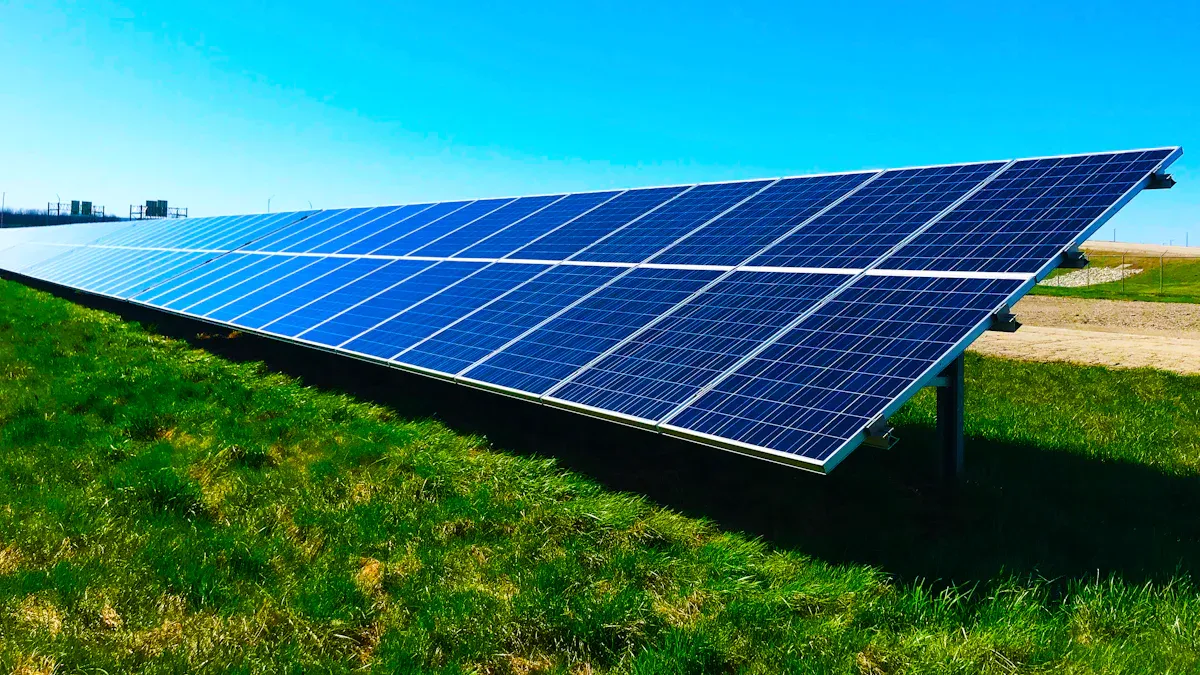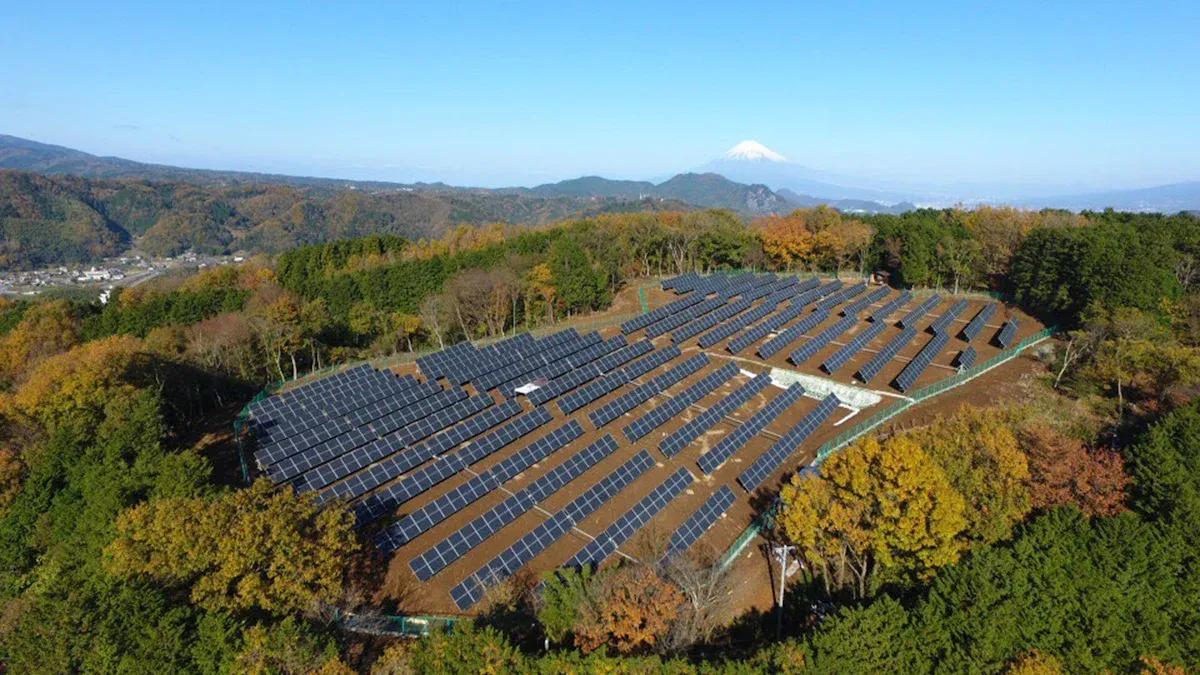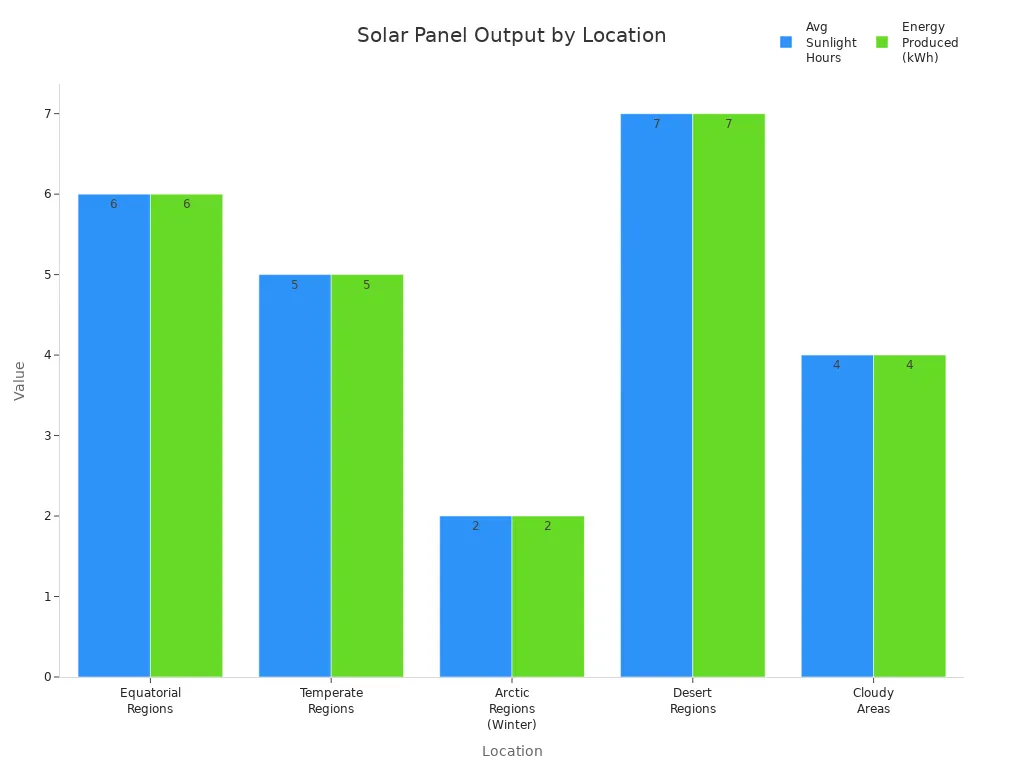A 1000 watt solar panel makes about 4 to 6 kilowatt-hours of electricity each day. This depends on how much sunlight and what the weather is like. Most people get about 5 kWh per day if their home gets 5 hours of strong sunlight.
Many things can change how much energy you get. Look at the table below:
| Factor | Impact on Output |
|---|---|
| Sunlight Hours | Sunlight can last 3 to 8 hours. This changes how much energy you get. |
| Temperature | For every 1°C rise, output drops by 0.4%. Hot days can lower output to 83% of what it should be. |
| Shading | Even a small shadow can cut output by 30%. |
| Equipment Efficiency | Inverter efficiency can get worse over time. This lowers the total system output. |
You can also save a lot on your electric bills. Many homeowners save 70% to 90% after getting solar panels. Many people also see their home value go up.
Key Takeaways
- A 1000 watt solar panel makes 4 to 6 kilowatt-hours each day. This depends on how much sunlight and what the weather is like.
- You can get more energy if your solar panel gets direct sunlight. Put it facing true south. Make sure it tilts the right way for your area.
- Cleaning your panels often helps them work better. It can make them give up to 30% more energy. Keep panels clean and out of shade.
- Use this formula to guess daily energy: Daily kWh = Panel Wattage × Peak Sun Hours ÷ 1000. This helps you know how much energy you get from sunlight in your area.
- Where you live is important! Places with lots of sun, like Arizona, make more energy. Places with less sun, like Seattle, make less energy.
1000 Watt Solar Panel Output

Daily kWh Range
When you use a 1000 watt solar panel, you can expect it to generate between 4 and 6 kilowatt-hours (kWh) of electricity each day. This range comes from real-world reports and matches what most homeowners see. If your area gets about 5 hours of strong sunlight, your panel will likely produce close to 5 kWh per day. In places with more sunlight, you might reach 6 kWh.
The highest possible output for a 1000 watt solar panel is 1 kWh per hour. This only happens in perfect lab conditions called Standard Test Conditions (STC). In real life, you rarely see this maximum because clouds, heat, and other factors lower the output.
You should remember that the daily range depends on your local weather, the time of year, and how you set up your panel. Even small changes, like a bit of shade or dirt on the panel, can lower the amount of electricity you get.
Sunlight Hours Impact
The number of sunlight hours your panel receives each day has a big effect on how much electricity it can make. Solar panels work best during peak sunlight hours, which means when the sun is strongest.
- The more peak sunlight hours you get, the more energy your 1000 watt solar panel will generate.
- If you live in a sunny place, your panel can work closer to its full power for longer periods.
- You can use this simple formula to estimate your daily output:
Panel Wattage × Peak Sunlight Hours ÷ 1000 = Daily kWh - For example, if you get 6 hours of peak sunlight, your panel could make up to 6 kWh in one day.
Tip: Track the average sunlight hours in your area. This helps you predict how much electricity your solar panel will provide throughout the year.
You can see that sunlight hours are one of the most important factors. If you want to get the most from your 1000 watt solar panel, try to install it where it will get the most direct sunlight each day.
Factors Affecting Output
Many things can change how much electricity your 1000 watt solar panel makes each day. You need to think about where you live, the weather, how you set up your panels, and how clean and efficient your system stays. Let’s look at each factor.
Location
Where you live matters most for solar power. Some places get more sunlight than others. If you live closer to the equator, you get stronger and more steady sunlight. For example:
- Arizona and California get more sun hours than northern states like Washington or New York.
- Arizona can get up to 7.5 peak sun hours a day, but Alaska may only get 2.5.
The more sunlight you get, the more electricity your solar panel will make. If you live in a sunny area, you will see higher daily output.
Weather
Weather changes how much energy your solar panel can make. Sunlight is best on clear days, but clouds, rain, and dust can lower output. Here is a quick look at how weather affects your system:
| Weather Condition | Impact on Output |
|---|---|
| Temperature Increase | Power drops 1.8% for every 5°C rise |
| Light Clouds (30% cover) | Generation drops only 15% |
| Heavy Clouds | Generation can drop by 50% |
| Rain (first three days) | Daily generation drops 40% |
| Dust Accumulation | Output drops faster in dusty air |
| Seasonal Variation | Winter can make 2.8 times less than summer |
You will see less power on cloudy or rainy days. Hot weather can also lower output.
Orientation
How you set up your solar panel changes how much sunlight it gets. You should point your panels toward the sun. In the Northern Hemisphere, face them true south. The tilt angle should match your location for the best results. If you get the angle and direction right, you will get more energy every day.
- Panels work best when they face the sun directly.
- The right tilt and direction can boost your daily output.
Efficiency Losses
Your solar panel system can lose power from shading, dirt, and system parts. Even a small shadow can cut output by a lot. Dust and dirt build up over time and block sunlight. Cleaning your panels can help you get 3% to 5% more energy. In very dusty places, cleaning can improve efficiency by up to 25%. Also, some energy gets lost in wires and inverters.
Keep your panels clean and free from shade to get the most from your system.
Calculate Output
Formula
You can estimate how much electricity your solar panel will make each day using a simple formula. This helps you plan your energy use and savings. The basic formula looks like this:
Daily kWh = Panel Wattage × Peak Sun Hours ÷ 1000
You also need to think about efficiency losses. These losses come from things like inverter heat, cable resistance, and temperature changes. Most systems lose about 15% to 22% of their power. You can use a derate factor to adjust for these losses. A derate factor of 0.75 is common for home solar setups.
Here is a table that shows the main parts of the calculation:
| Component | Description |
|---|---|
| Panel Wattage in kW | 1 kW for a 1000 watt solar panel |
| Peak Sun Hours | Number of sunlight hours per day |
| Derate Factor | Efficiency loss factor (usually around 0.75) |
| Daily Energy Output (kWh) | 1 kW × Peak Sun Hours × Derate Factor |
Tip: Peak sun hours are not the same as daylight hours. You should use the hours when sunlight is strongest.
Example
Let’s see how you can use this formula with real numbers. Imagine you have a 1000 watt solar panel at your home. You get 5 peak sun hours each day. Your system has a derate factor of 0.75 because of normal losses.
- Panel Wattage: 1 kW
- Peak Sun Hours: 5
- Derate Factor: 0.75
Plug these numbers into the formula:
Daily kWh = 1 kW × 5 × 0.75 = 3.75 kWh
If you live in a sunnier place and get 6 peak sun hours, your output goes up:
Daily kWh = 1 kW × 6 × 0.75 = 4.5 kWh
You can see that more sun hours mean more electricity. If your system runs at higher efficiency, you get even more power. Small changes in tilt angle or temperature can lower your output. For example, a tilt error of 5° can cost you up to 8% in generation efficiency. Hot days can also drop your power by about 0.4% for every degree Celsius.
You should check your local sun hours and system efficiency to get the best estimate for your solar panel’s daily output.
Output by Location

City Comparison
Where you live makes a big difference in how much electricity your solar panels can make. Some cities get more sunlight than others. You can see this in the table below. It shows the average daily output for a 1000 watt solar panel in three major U.S. cities.
| City | Peak Sun Hours | Daily Output (Wh) |
|---|---|---|
| Phoenix | 6.52 | 652 |
| Seattle | 3.97 | 397 |
| Miami | 5.26 | 526 |
If you live in Phoenix, your solar panel will make much more electricity than if you live in Seattle. Miami falls in the middle. This happens because Phoenix gets more strong sunlight each day. You should always check the average sun hours for your city before you install solar panels.
Tip: The more peak sun hours your city gets, the more energy you can expect from your solar system.
Seasonal Change
Seasons also change how much power your solar panels make. In summer, you get longer days and more sunlight. In winter, days are shorter and the sun sits lower in the sky. This can cut your solar output by 40% to 60%. Sometimes, output drops by as much as 80% in northern areas.
- In summer, you might see over 16 hours of daylight.
- In winter, daylight can drop to just over 7 hours.
- Cloudy weather and low sun angles in winter can lower your output even more.
- Self-shading from low-angle sunlight can cause up to 27% loss on the shortest day.
- High temperatures in summer can also lower efficiency by about 1.8% for every 5°C rise.
You may notice higher electric bills in winter because your panels make less power. Planning for these changes helps you get the most from your solar system all year.
Maximize Generation
Installation Tips
You can get more electricity from your 1000 watt solar panel by setting it up the right way.
- Clean the spot before you start. Take away trash and let air move around the panel.
- Put the panel so it faces true south if you live in the Northern Hemisphere. Change the tilt so it matches where you live for the best sunlight.
- Use strong wires and good connectors. Good parts help stop energy from being lost.
- Make sure trees or buildings do not block the sun. Even a little shade can lower how much power you get.
- Check for loose wires and make sure everything works after you finish.
Tip: Setting up your system carefully at the start helps you avoid trouble and gives you more energy each day.
Maintenance
Taking care of your solar panel helps it work well for a long time.
- Wash your panels once or twice a year. If you live where it is dusty, clean them more often.
- Hire cleaning experts every six months to a year for a deep clean.
- Look at your system for dust, pollen, or broken parts. Checking early helps you fix problems before they get worse.
- Clean panels can make up to 30% more power than dirty ones.
- If you do not take care of your panels, they will make less energy and not last as long.
Note: Cleaning and checking your panels often keeps your system safe and saves you more money.
Monitoring
You can use new tools to watch how your solar panel is working. These tools help you find problems early and keep your system running well.
| Tool Name | Description |
|---|---|
| PV Solar Panel Monitor | Watches how much power your panel makes and lets you see the data online. |
| Solar Panel Monitoring Apps | Shows you live power numbers and helps you find problems without extra tools. |
| Solar Testing Equipment | Checks and tests your system so you can fix things fast. |
| Solar Monitoring Systems | Gives you easy charts and numbers about your power each day. |
| Benefit | Description |
|---|---|
| Real-Time Monitoring | Shows you what is happening right now so you can fix problems fast. |
| Early Detection of Anomalies | Helps you find issues quickly, so repairs cost less and your system is down for less time. |
| Performance Metrics Tracking | Lets you see how much energy you use and helps you use your solar power better over time. |
Tip: Using monitoring tools helps you find problems early and keeps your solar panel working its best.
A 1000 watt solar panel can make 2 to 7 kWh each day. How much it makes depends on where you live and the weather. The main things that change your output are sunlight, temperature, shading, soiling, and snow. Here is a table that explains these factors:
| Factor | Description |
|---|---|
| Irradiance | More sunlight on the panel means more energy made. |
| Temperature | Hotter days make the panel work less well. |
| Shading | Shade makes the panel give less power. Shade changes with the seasons. |
| Soiling | Dust and dirt block sunlight. You may need to clean panels in dry places. |
| Snow | Snow covers the panel and stops it from making power. In winter, this can be a big problem. |
How much sunlight you get in your area matters a lot. You can use a simple formula to guess how much power you will get. The chart below shows how much energy a 1000 watt solar panel can make in different places:

Tip: Keep your panels clean, put them in a sunny spot, and check them often to get the most power.
FAQ
How much money can you save with a 1000 watt solar panel?
You can save $20 to $40 each month on your electric bill. Your savings depend on your local rates and how much sunlight you get. Many homeowners see their bills drop by 70% or more.
What happens if your solar panel gets dirty or covered with snow?
Dirty panels or snow block sunlight. You get less electricity. Clean your panels often and remove snow quickly. This helps you keep your system working well.
Can you use a 1000 watt solar panel to power your whole house?
A 1000 watt solar panel can run small appliances and lights. You need more panels to power your whole house. Most homes use 20 to 30 kWh each day.
How long does a 1000 watt solar panel last?
Most solar panels last 25 to 30 years. You may see a small drop in output each year. Good care and regular cleaning help your panel work longer.
See also
How to calculate the power generation of a 400 watt solar panel
How many volts can a 100 watt solar panel generate?
Is a 3 kW Solar System Suitable for Your Home’s Energy Demands
How many watts can a 20 ampere circuit breaker handle
What is string solar inverter and how does it work



